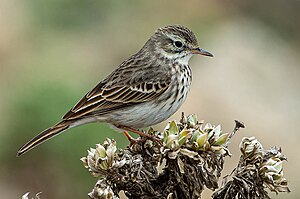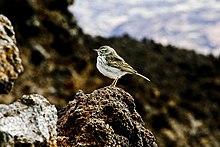Canary Pipit
| Canary Pipit | ||||||||||||
|---|---|---|---|---|---|---|---|---|---|---|---|---|

Canary Pipit on Fuerteventura |
||||||||||||
| Systematics | ||||||||||||
|
||||||||||||
| Scientific name | ||||||||||||
| Anthus berthelotii | ||||||||||||
| Bolle , 1862 |
The Canary Pipit ( Anthus berthelotii ) is a songbird species from the family of stilts and pipiters . He's on the Canary Islands , the Selvagens and Madeira endemic , where he dry, grassy and bush-lined habitats inhabited and the only breeding there is Pieperart. It is a resident bird , of which there has so far been no evidence as a random visitor outside of its range. The population is roughly estimated at 20,000–100,000 breeding pairs and according to the IUCN the species is not threatened (“least concern”). The specific epithet honors the French naturalist Sabin Berthelot .
description
The Canaries Pieper is the closely related Tawny Pipit not dissimilar, but much smaller, from 13.0 to 14.5 cm body length, dashed oberseits more gray and white hand more and much clearer. The wing length is between 73 and 81 mm, the tail length between 53 and 62 mm. The head is relatively large, the body quite short. The relatively slender beak is 14.5–16.0 mm long. The upper bill is dark to medium gray and shows flesh-colored lower edges, the pale flesh-colored lower bill has a dark tip and sometimes light yellowish edges. The legs and feet are flesh-colored and sometimes slightly yellow, the claws significantly darker. The iris is dark brown, the eye shows a light ring. There is no sexual dimorphism .
The upper side of adult birds is gray-brown with a distinct, dark stripe on the vertex and a somewhat fuzzy one on the back and neck. The rump is not drawn. The wide, long stripe above the eyes is whitish, as are chin, throat and beard stripe . The latter is delimited by a dark stripe from the ear covers, which are slightly lightened in the center. The reins and chin stripe are dark brown. The underside is whitish and slightly yellowish to reddish beige in the fresh plumage. The chest is strong dark brown, the flanks a little more finely dashed, but sometimes almost unbroken. The marginal coverts are gray-brown like the top, the rest of the wing plumage is black-brown and shows beige hems. The tips of the arm covers are very broad and light, so that they form light wing bands. Since the hems of the middle arm covers are narrow, the dark centers also stand out as a wide, contrasting band. The control feathers are predominantly black-brown, the middle pair a little lighter with beige edges. The outer three show a light-colored wedge on the outer flag, which becomes longer towards the outer sides of the tail, which appear whitish as a result.
The seasonal variation is slight and only comes about through plumage wear. Every year after the breeding season, i.e. between July and August, there is a full moult.
Canary pipit in youthful dress are much more contrasting in color than adult birds. The top is darker and more brown and has a scaly effect due to dark feather centers and light hems. The underside is more intense white, the dotted lines on the chest are very broad. The hems of the wing feathers are warmer beige and especially on the arm covers very light.
voice
The vocal repertoire is very similar to that of the Brachpieper. The call (audio sample) is similar to that of the yellow wagtail and is a soft tschlie or tschirlie . The chant is similar to the call and is a very simple, constant repetition of two-syllable sounds, which sounds something like tzirlie tzirlie tzirlie tzirlie… . In contrast to the Brachpieper, the pitch of the voice is slightly higher.
Distribution and existence
The Canary Pipit occurs exclusively on the Canaries, the Ilhas Selvagens as well as on Madeira, Porto Santo and the Ilhas Desertas . The population in the Canary Islands is estimated at 20,000-100,000 birds and the species is one of the most common open-land inhabitants on Lanzarote . Here, population densities of 37 breeding pairs / 10 ha were found in some areas . On Selvagem Grande the population is subject to strong fluctuations due to the weather conditions; the core population here was estimated at 50 breeding pairs in the 1990s. Another 500–1000 breeding pairs are believed to be found on Madeira.
Geographic variation
Two subspecies are described, of which the nominate form on the Canary Islands and the Ilhas Selvagens and the slightly more long-beaked subspecies A. b. madeirensis Hartert , occurs in Madeira in 1905. However, since the difference is extremely small and other distinguishing features are based on undifferentiated measurements, the species is viewed as monotypical by Alström & Mild (2003) .
habitat
The Canary Pipit lives in open, dry, bushy and sometimes rocky areas. In Madeira, the species can be found mainly in the grasslands of the high plateau, but also in dry pastureland on the coast. The altitude distribution in the Canaries ranges from sea level to 3000 meters. Here you can find the Canary Pipit in a broader spectrum of habitats such as open arable land, bushy mountain slopes, dunes and semi-deserts as well as dry clearings within wooded areas.
Reproduction
The breeding season appears to be of variable length and ranges from January to August. It is believed that there is often more than one annual brood. The nest is a deep bowl made of stalks and fibers that is lined with soft material such as animal hair and feathers. It is erected in the cover of dry vegetation, bushes, stones or partly low in euphorbias . The clutch consists of 2–5 round oval, shiny eggs, which are speckled brownish on a light gray background and are 19.5 × 14.8 mm in size.
literature
- Per Alström, Krister Mild: Pipits and Wagtails of Europe, Asia and North America , Christopher Helm, London 2003, ISBN 0-7136-5834-7
- P. Oliveira, F. Zino: Anthus berthelotii in WJM Hagemeijer, MJ Blair: The EBCC Atlas of European Breeding Birds - their distribution and abundance , T & AD Poyser, London 1997, ISBN 0-85661-091-7 , p. 483
- L. Svensson, PJ Grant, K. Mularney, D. Zetterström: Der neue Kosmos-Vogelführer , Franckh-Kosmos Verlags-GmbH, Stuttgart 1999, ISBN 3-440-07720-9
- C. Harrison, P. Castell, H. Hoerschelmann: Young birds, eggs and nests of birds - Europe, North Africa and the Middle East , Aula Verlag, Wiebelsheim 2004, ISBN 3-89104-685-5
Web links
- Anthus berthelotii in the Red List of Threatened Species of the IUCN 2008. Posted by: BirdLife International, 2009. Accessed January 5 of 2010.
- Videos, photos and sound recordings of Anthus berthelotii in the Internet Bird Collection
- BirdLife species factsheet , accessed January 5, 2010
- xeno-canto: sound recordings - Berthelot's Pipit ( Anthus berthelotii )
Individual evidence
- ↑ Herman van Oosten: XC37468 · Kanarenpieper · Anthus berthelotii (MP3) xeno-canto.org. August 4, 2009. Retrieved June 2, 2019.
- ↑ EBCC Atlas of European Breeding Birds, s. Literature and BirdLife Species Factsheet


